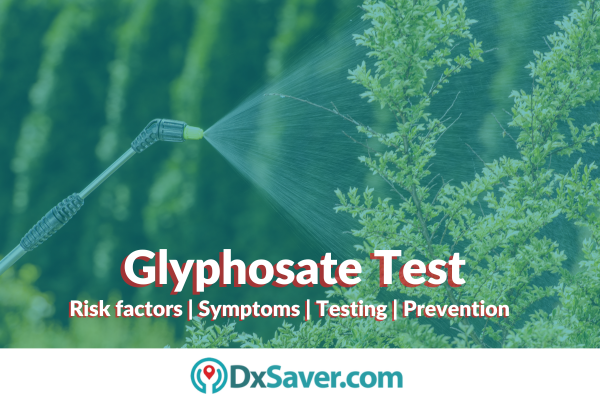
Do you know what glyphosate is? Why do you need a glyphosate test? Because glyphosate is a commonly used herbicide that has made headlines because of concerns about possible health effects, a glyphosate test is necessary to measure the exposure of glyphosate in your food.
In this blog, you will learn more about glyphosate testing, detailing its exposure, symptoms, and also preventive measures that can be taken.
- What is Glyphosate?
- How does Glyphosate work?
- What goes on with glyphosate after its usage?
- How do you get exposed to Glyphosate?
- What are the symptoms and indicators of glyphosate exposure?
- Does glyphosate exposure lead to health hazards?
- Does the Glyphosate test help in reducing glyphosate exposure?
- When to take the glyphosate test?
- What do the test results of the glyphosate test mean?
- How to prevent glyphosate exposure?
For our readers, who are more interested in knowing the Glyphosate test cost beforehand, we begin with that section.
How much does the Glyphosate test cost?
The Glyphosate test costs $79 in the U.S. The cost of this test also depends on your choice of visiting the nearest lab or getting tested at home using the home test kit. Complete the procedure and get the results in your email within 30 minutes. Doctor consultation is also available for further treatment or medical advice.
The following table shows the Glyphosate test kit cost by one of our partners located in the U.S.
Name of our Partner Lab | Book Online |
EmpowerDx Lab(Home Test Kit)
| Offer Price$79 |
What is Glyphosate?
Glyphosate is a widely used crop weedkiller or herbicide in the United States. It helps to eradicate plants, weeds, and grasses. Uses of glyphosate are in agriculture, lawn care, horticulture, forestry, and factory environments. These chemicals customarily remove weeds before sowing maize for cattle feed.
Nonetheless, in the past few years, glyphosate has been used to hasten the harvest of crops that fall under genetically modified organisms (GMOs). Based on the temperature and soil type, you can spray your crops with herbicide spray two weeks before harvest. The glyphosate herbicide stays in the ground for up to six months.
How does Glyphosate work?
Being a non-selective herbicide, glyphosate functions by killing plants. It hinders the production of several proteins that plants require for development. The shikimic acid route is one particular enzyme pathway that glyphosate blocks. The shikimic acid pathway is necessary for plants and some microorganisms.
Glyphosate penetrates plants mainly through their leaves, and only trace quantities of glyphosate make their way into the roots. Consequently, glyphosate kills only growing weeds and grass.
What goes on with glyphosate after its usage?
Glyphosate sticks to the soil quite firmly. Depending on the temperature and the kind of soil, it can remain in the soil for up to 6 months. Bacteria in the soil may break down glyphosate.
Glyphosate adheres to soil strongly, making it unlikely for it to enter groundwater. However, it may be transported to groundwater, surface water, and land beyond the spray zone through surface runoff, drift, and aerial transmission. According to studies, the glyphosate in dead leaves degrades after 8 or 9 days. Once glyphosate is applied to the soil, lettuce, and carrots may absorb glyphosate.
How do you get exposed to Glyphosate?
You are exposed to glyphosate through the following methods:
- Direct skin contact
- Breathing in airborne particles
- Consuming glyphosate-containing food
You probably eat glyphosate-containing food more frequently than you realize because there is a possibility that residues of glyphosate stay on food even after food harvesting and packaging. Any crop sprayed with glyphosate poses a risk.
The crops frequently sprayed with Glyphosate are:
- Beans
- Barley
- Corn
- Oats
- Soybeans
- Wheat
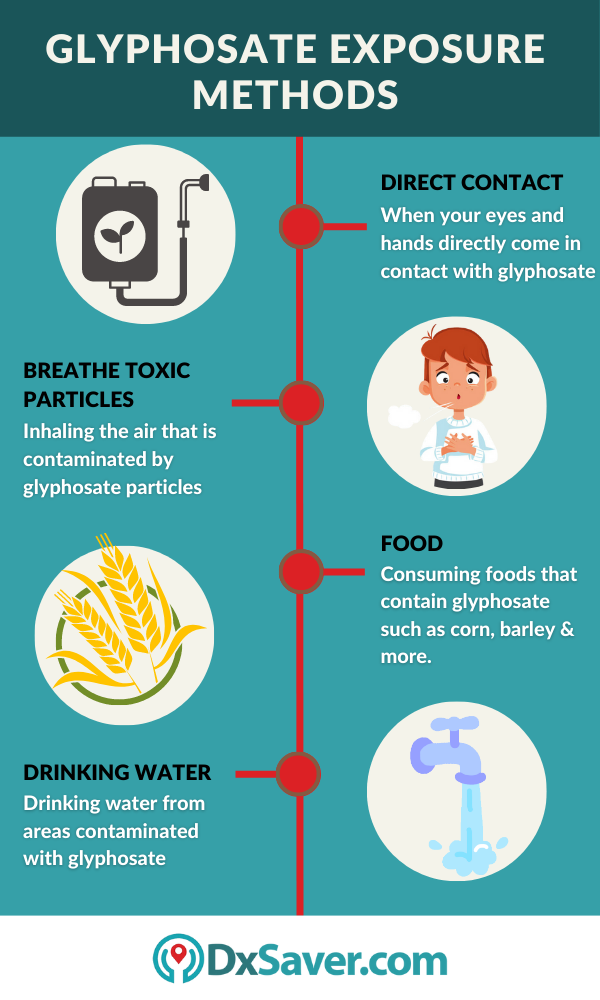
What are the symptoms and indicators of glyphosate exposure?
Warning signs of glyphosate exposure are listed as follows:
- Glyphosate-containing goods can irritate the skin.
- If glyphosate enters your eyes, it could cause corneal damage or moderate eye discomfort.
- People who inhale spray mist from glyphosate-containing goods experience throat and nose discomfort.
- Swallowing glyphosate-containing commodities could lead to
- Salivation
- Mouth and throat burn
- Nausea
- Vomiting
- Diarrhea
- Abdominal discomfort
- Hypotension
- Instances of purposeful consumption result in fatalities.
- When exposed to glyphosate-containing goods, animals may drool, throw up, have diarrhea, lose their appetite, or become tired
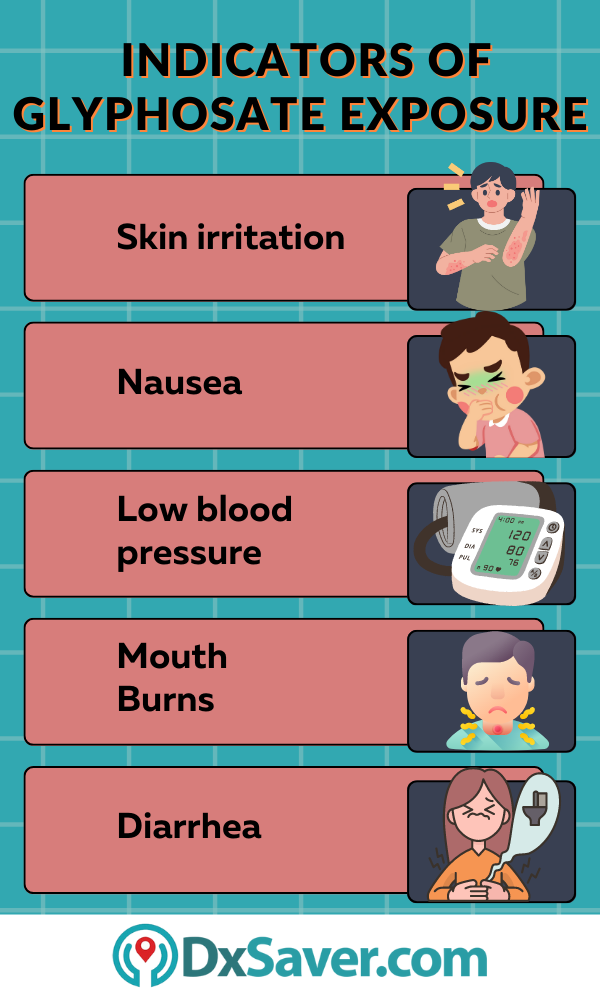
Does glyphosate exposure lead to health hazards?
You need not be concerned about short-term glyphosate exposure. However, its potential long-term risk could be a cause for concern. The following are the risk factors due to glyphosate exposure:
- Kidney and liver damage: Your kidney and liver are affected by glyphosate. Studies show signs of liver damage among dairy cows if they eat soybean or a diet rich in glyphosate.
- Children and expectant mothers are at risk: Due to the increased susceptibility of youngsters and growing fetuses to carcinogens, several experts are worried that pregnant women and children may face dangers.
- Disruption of the endocrine system: Glyphosate may interfere with animal hormone systems, which later on affects human health. It also affects estrogen and androgen receptors, which are crucial for the control of reproductive and developmental processes.
- Cancer: The International Agency for Research on Cancer (IARC) has categorized glyphosate as a probable human carcinogen. Thus, Glyphosate exposure may cause non-Hodgkin’s lymphoma, a type of cancer.
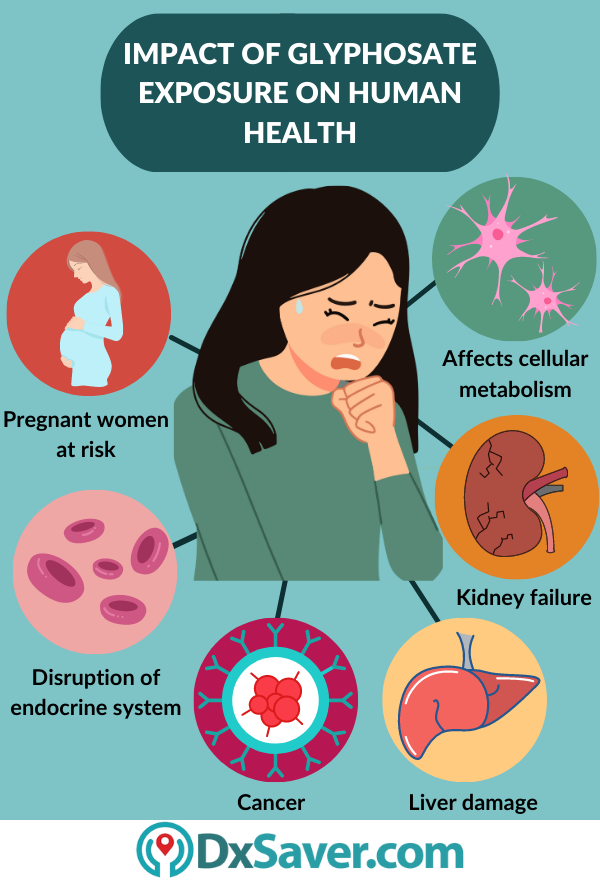
Does the Glyphosate test help in reducing glyphosate exposure?
Glyphosate tests help detect potential sources of glyphosate exposure and can guide people and organizations to lower their exposure to this substance. Glyphosate testing in food ensures that food items adhere to the permitted levels of glyphosate residues. The quantity of chemical pesticide residue in food in the U.S. is assessed and regulated by the Environmental Protection Agency (EPA).
An at-home test kit from empowerDX consists of two packs that allow you to find glyphosate in foods you frequently eat. The home test kit performs a complete qualitative evaluation of glyphosate. You need not send samples to the lab and also receive quick results in 30 minutes.
The glyphosate test checks the following food items:
- Whole oats
- Infant cereals
- Cereals
- Honey
- Dried soya beans
- Water
- Beer
When to take the glyphosate test?
You could get a glyphosate test if you’re worried about glyphosate exposure. In the following circumstances, you might want to think about getting a glyphosate test:
- If you routinely come into contact with glyphosate by working on farms.
- If you are surrounded by agricultural regions that frequently employ glyphosate.
- if you’ve eaten any potentially glyphosate-contaminated food or water.
What do the test results of the glyphosate test mean?
Glyphosate testing is performed on food and water samples to determine the glyphosate concentrations safe for consumption. A glyphosate test usually gives test results that measure the quantity of glyphosate in your sample. The results reported use units such as parts per billion (ppb) or parts per million (ppm).
If the results of the glyphosate test show that the sample has higher levels of glyphosate than the permitted limits, then taking remedial action to lessen exposure to glyphosate may be essential.
How to prevent glyphosate exposure?
In addition to minimizing the intake of contaminated food or water, you are recommended to take the following preventive measures:
- Use protective clothing: If you are dealing with glyphosate, use gloves, boots, long pants, and long-sleeved shirts.
- Consider alternatives: Instead of applying glyphosate, consider manual weeding or mulching.
- Wash your hands: When you work with glyphosate, wash your hands with soap and water.
- Safe storage: Safely store glyphosate-containing items in a cold, dry, and well-ventilated environment that is out of the reach of children and animals.
- Use equipment for protection: Use safety equipment to safeguard your eyes, lungs, and other vital organs against glyphosate exposure. Examples of such gear include respirators and goggles.
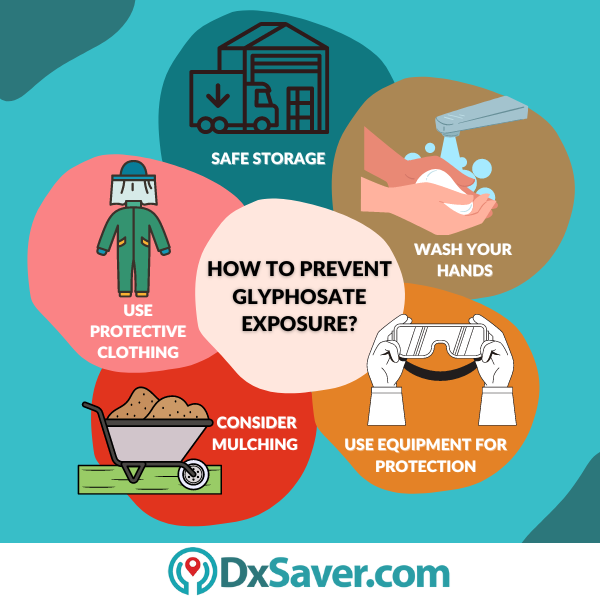
Frequently asked questions (FAQs):
Can you find glyphosate residue in food?
A: Some food items, especially those manufactured from genetically modified crops may contain glyphosate residue. Nevertheless, regulatory guidelines typically deem safe quantities of residue detected in food.
How reliable is the glyphosate test?
A: Accredited labs that use standardized procedures can deliver accurate findings.
How do I use an at-home glyphosate test kit?
A: To use an at-home glyphosate test kit, select the food item you wish to test from the list provided in the kit. Then, carefully follow the instructions included in the kit to prepare the food sample and administer the test.
Why is testing for glyphosate important?
A: Cancer and other diseases have been linked to glyphosate as a health risk. Glyphosate testing is important because it has the potential to detect exposure to glyphosate in food, water, and other sources, which can enable individuals to make informed decisions regarding their consumption.
Other topics that you may be interested in: –
- Symptoms of poor gut health
- Diagnosis for MTHFR Gene mutations
- How much does it cost for a mental health test in the U.S.?
- Importance of APOE Gene Test
- Guide on skincare
- How much does the vaginitis test cost in the U.S.?
- Why do you need a mineral test?
- At-Home Chlamydia Testing in the US
- Order an at-Home Syphilis Test Kit
- STD Testing in NYC (New York City)
- Treatment for Inflammation in Men and Women
- Treatment for micronutrient deficiency
- Importance of essential vitamins





